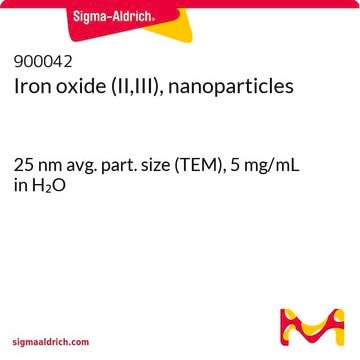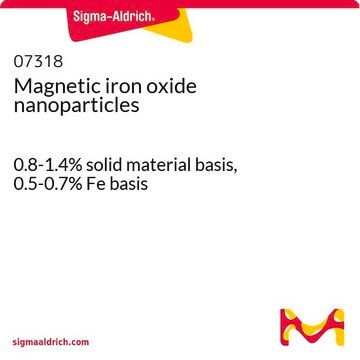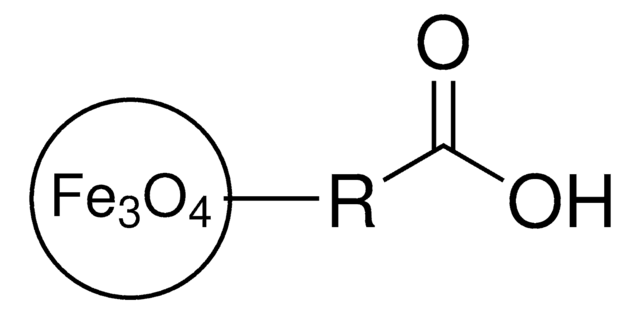725366
Iron oxide(II,III), magnetic nanoparticles solution
20 nm avg. part. size, 5 mg/mL in H2O
Synonym(s):
Magnetic iron oxide nanocrystals, Magnetite, Superparamagnetic iron oxide nanoparticles
Sign Into View Organizational & Contract Pricing
All Photos(1)
About This Item
Empirical Formula (Hill Notation):
Fe3O4
CAS Number:
Molecular Weight:
231.53
MDL number:
UNSPSC Code:
12352302
PubChem Substance ID:
NACRES:
NA.23
Recommended Products
form
dispersion
nanoparticles
concentration
5 mg/mL in H2O
magnetization
>20 emu/g, at 4500Oe
particle size
18-22 nm
avg. part. size
20 nm
density
1.00 g/mL at 25 °C
SMILES string
O=[Fe].O=[Fe]O[Fe]=O
InChI
1S/3Fe.4O
InChI key
SZVJSHCCFOBDDC-UHFFFAOYSA-N
Looking for similar products? Visit Product Comparison Guide
General description
Concentration 5mg/ml includes total weight nanocrystals plus ligands.
Application
- Magnetic iron oxide nanoparticle (IONP) synthesis to applications: present and future: This report outlines the co-precipitation synthesis of magnetite nanoparticles using Fe(II) and Fe(III) solutions and discusses their future applications (N Ajinkya et al., 2020).
- Surface modification of magnetic iron oxide nanoparticles: Explores the surface engineering of iron oxide nanoparticles (IONPs) to enhance their functionality for various applications (N Zhu et al., 2018).
- Recent advances on iron oxide magnetic nanoparticles as sorbents of organic pollutants in water and wastewater treatment: Discusses the use of iron oxide magnetic nanoparticles in removing organic pollutants from water, highlighting the synthesis of core-shell magnetic nanoparticles (AM Gutierrez et al., 2017).
- Potential toxicity of iron oxide magnetic nanoparticles: Reviews the potential toxic effects of iron oxide magnetic nanoparticles, emphasizing their stability, biocompatibility, and size control (N Malhotra et al., 2020).
- Co-precipitation in aqueous solution synthesis of magnetite nanoparticles using iron (III) salts as precursors: Details the synthesis process of iron oxide nanocrystals and their potential applications in various fields (MI Khalil, 2015).
Storage Class Code
12 - Non Combustible Liquids
WGK
nwg
Flash Point(F)
Not applicable
Flash Point(C)
Not applicable
Choose from one of the most recent versions:
Already Own This Product?
Find documentation for the products that you have recently purchased in the Document Library.
Customers Also Viewed
Leyong Zeng et al.
Nanoscale, 5(5), 2107-2113 (2013-02-06)
Multifunctional Fe(3)O(4)-TiO(2) nanocomposites with Janus structure for magnetic resonance imaging (MRI) and potential photodynamic therapy (PDT) were synthesized, in which Fe(3)O(4) was used as a MRI contrast agent and TiO(2) as an inorganic photosensitizer for PDT. Their morphology, structure, and
Aman Khurana et al.
Radiology, 269(1), 186-197 (2013-07-16)
To determine whether intravenous ferumoxytol can be used to effectively label mesenchymal stem cells (MSCs) in vivo and can be used for tracking of stem cell transplants. This study was approved by the institutional animal care and use committee. Sprague-Dawley
Lu Zhang et al.
Nanoscale, 5(17), 7664-7684 (2013-07-24)
Superparamagnetic iron oxide nanoparticles (SPIONs) have shown great promise in biomedical applications. In this review, we summarize the recent advances in the design and fabrication of core-shell and hetero-structured SPIONs and further outline some exciting developments and progresses of these
M A Olutoye et al.
Bioresource technology, 132, 103-108 (2013-02-12)
An active heterogeneous Al2O3 modified MgZnO (MgZnAlO) catalyst was prepared and the catalytic activity was investigated for the transesterification of different vegetable oils (refined palm oil, waste cooking palm oil, palm kernel oil and coconut oil) with methanol to produce
Oliver Raschdorf et al.
Molecular microbiology, 89(5), 872-886 (2013-07-31)
Magnetospirillum gryphiswaldense uses intracellular chains of membrane-enveloped magnetite crystals, the magnetosomes, to navigate within magnetic fields. The biomineralization of magnetite nanocrystals requires several magnetosome-associated proteins, whose precise functions so far have remained mostly unknown. Here, we analysed the functions of
Our team of scientists has experience in all areas of research including Life Science, Material Science, Chemical Synthesis, Chromatography, Analytical and many others.
Contact Technical Service




